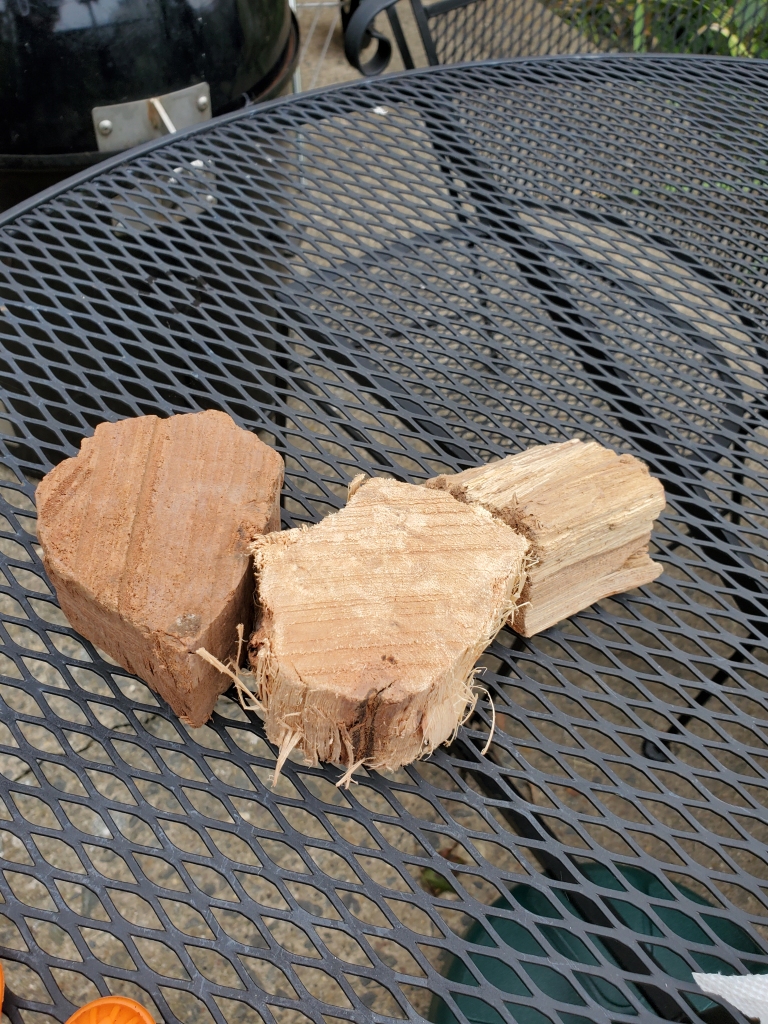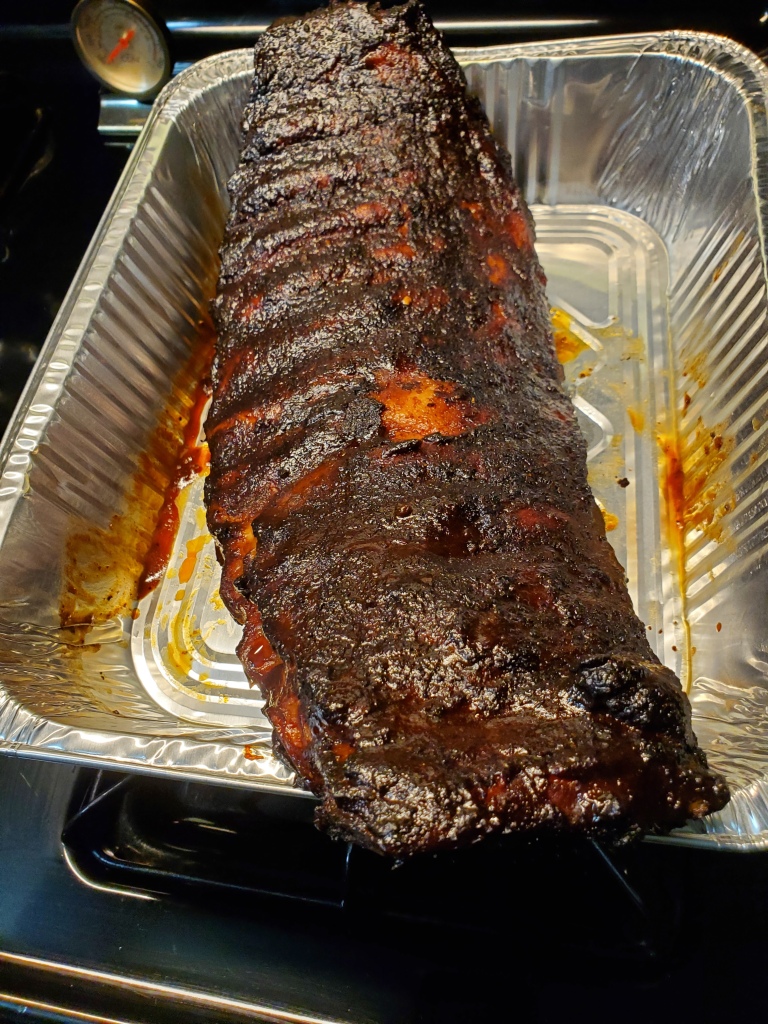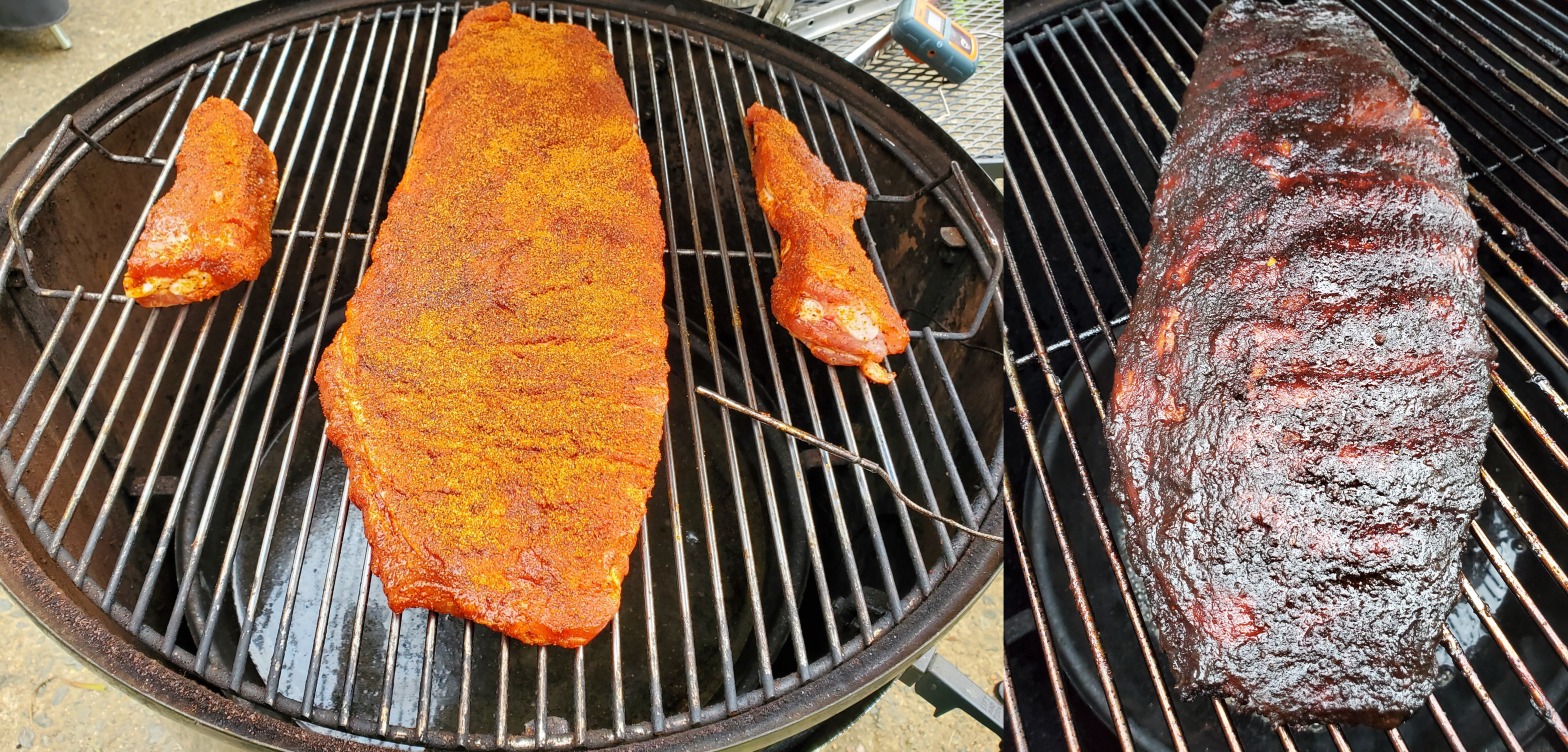I learned to barbecue initially by watching videos on YouTube. After viewing enough of them, I had a good idea of what the consensus methods were for smoking various cuts of meat, be it on the charcoal kettle grill I initially used or the Weber Smokey Mountain I’ve had for the past half-dozen or so years. And one of the rules observed by the vast majority of pitmasters is that pork ribs get wrapped in foil with a little liquid for a steam bath during a portion of the cooking process.
While I’ve always thought it would be nice to not have to go through the wrapping process and just leave the ribs on the cooking grate uninterrupted until they are done, I had never tried it until Friday. For reasons that remain a mystery, the urge to try it hit me earlier in the week, and I picked up a rack of spare ribs Thursday for smoking the following day.
The reason baby-back and spare ribs are usually wrapped is to avoid what is felt by many to be the likelihood that they’ll wind up dry if they aren’t given a steam bath inside a thick layer of foil for an hour or two. This is generally done after they’ve had enough time to absorb smoke and for the spice rub to firmly set – around 2-3 hours. Then they are finished up for a half hour or so back on the cooking grate with a barbecue sauce glaze if desired.
I’ve had fairly good luck, but also some consistency issues with that method over the years. So I went back to YouTube to check out a few more videos – this time of ribs being smoked without being wrapped at any point – and liked what I saw. In each one, the pitmaster felt that it was important to spray the ribs every 30-45 minutes with the liquid that would otherwise be going into the foil wrap. That seemed simple enough. I usually spray ribs a couple times anyway. I would just have to do it more often.

For those getting started with backyard barbecue, I advise getting your ribs from a butcher if there is one convenient to you. They are usually willing to remove the membrane, a necessary step that I’ve always found difficult to do at home. In my case, the guy who helped me also carved off a couple large pieces to turn the rack into something just a little shy of St. Louis style. I cooked those on the smoker alongside the bigger rack of ribs.
My preferred rub for pork barbecue the past few years has been Yardbird from Plowboys BBQ. I applied it liberally about 90 minutes before I threw the ribs onto the smoker.





To begin the process of heating the smoker, I like to use a charcoal chimney starter – filled about half way – and dump the burning coals on to the edge of my unlit larger charcoal pile. That will enable the pile to burn slowly.
The first wood chunk gets added around the same time I put the ribs on the smoker. I used a couple chunks of hickory and one of cherry-wood today. I happen to like a strong smoke flavor when I eat barbecue. Some people like it to be more subtle. One large or a couple smaller chunks would be enough in that case.
It took longer than usual for the cooking surface to get up to my desired temperature of 225-250. The slightly chilly weather may have had something to do with that.








The ribs went on at 10:45 a.m.. I didn’t open the lid to check on them until 12:30 p.m. That was when I started spraying the meat at 45 minute intervals. I used a mixture of two-parts apple juice to one-part apple cider vinegar. When I checked that first time, the two smaller separate pieces definitely needed a spray as they were looking a little dry on the outside. The rack of ribs was still moist in a couple spots, so I was careful with where I sprayed it. I didn’t hold back with the liquid when making ensuing visits to the smoker, which I was able to monitor inside the house with a remote receiver.





One of the detached pieces felt soft enough to come off the smoker at 2:45 p.m. I immediately took it inside the house, applied a glaze of barbecue sauce and topped it with a foil tent. I was getting hungry about an hour later and ate it. My first glimpse of how the no-wrap experiment was going was extremely promising.
Another discovery I made as the afternoon wore on was that it takes longer for the ribs to cook when they don’t get their foil steam bath; something that came up on a couple of the videos I watched. Finally, at 5:15 p.m., six-and-a-half hours after I put the ribs on the smoker, I felt they were ready to be glazed before spending a final 30 minutes on there. The common test used to determine when this point is reached is to pick up the rack with tongs and see how far the two ends bend down. The closer they are to facing straight down, the nearer the ribs are to being finished.
My barbecue sauce of choice was Bone Suckin’, which has a sweet flavor profile, with a little hot sauce added for zip.



At 5:45 p.m. I opened the smoker lid to see the final result and removed the rack of ribs into a foil pan before taking them inside.



That was a seven-hour cook. When I use foil it usually takes 4-4.5 hours for baby-backs and about an hour longer than that for spare ribs. So skipping the foil wrap added 90 minutes to two hours to the process. That’s a nice chunk of time. The ribs would have to be extremely good to make it worthwhile.
And they were. I’d have to put them up there with the best I’ve made. While I’ve had success using the foil method, it’s harder to control how the ribs turn out in the end. I’ve left them in the foil a little longer than I should have a few times and wound up with the rack getting too soft and falling apart when I went to pick it up or carve it.
In this case, the meat had what I consider to be the ideal consistency. It wasn’t fall-off-the-bone, which I know is how a lot of people prefer it. But it was soft, juicy – even without the steam bath – and pulled away from the bone easily with each bite.




While there was sugar in both the rub and sauce that I used, which contributed to the ribs’ dark finished surface, they tasted much more savory than sweet, with the hickory – my favorite smoking wood – shining through to add an additional layer of flavor.
Unless I’m working under time constraints, moving forward, I see myself foregoing the foil steam bath when smoking ribs. It’s probably easier to control the finished product without it, and the only thing I had to sacrifice was a couple hours of my time.
My fellow food blogger, John Tanner, who I thank for being so supportive of my efforts here, has put out a call for help on his blog. He puts together wonderful guides for where to find barbecue – among other cuisines – in the Mid-Atlantic and Southeast regions and needs suggestions for the one he is currently working on for Maryland. If anyone reading this knows of any good barbecue in Maryland, please let John know about it.
Here are his ten best Eastern North Carolina barbecue purveyors. And here is another valuable one for those who drive I-95 between Florida and Washington, D.C.

Nice smoke ring!
LikeLiked by 1 person
Thanks so much for the links!
Now, those are some good looking ribs! I can almost smell them!
And I agree completely about not wrapping and thus steaming the ribs (or any meat) in foil.
LikeLiked by 1 person
I haven’t smoked a brisket in a long time, but I switched from foil to butcher paper for those at some point when I was still making them.
It’s definitely nice to work with a cut of meat that can stay on the cooking grate without interruption until it’s finished.
LikeLike
I’ve never wrapped meat, but then I haven’t cooked brisket in decades. It costs several times as much as pork, which I prefer. My son-in-law, Michael, does excellent briskets on his Big Green Egg – and delicious smoked chickens. He always wraps them in butcher paper to rest for some hours, I think.
That really was a good report.
LikeLiked by 1 person
Thanks. I’ve heard those Big Green Eggs are easy to work with in terms of temperature control. I had a relatively smooth time yesterday considering how often I opened the lid. My usual philosophy is to not open it as often to spray as recommended because I don’t want to upset the temperature.
LikeLike
Very nice ribs! I’ve never wrapped them during or after cooking, and have usually been happy with the results.
LikeLiked by 1 person